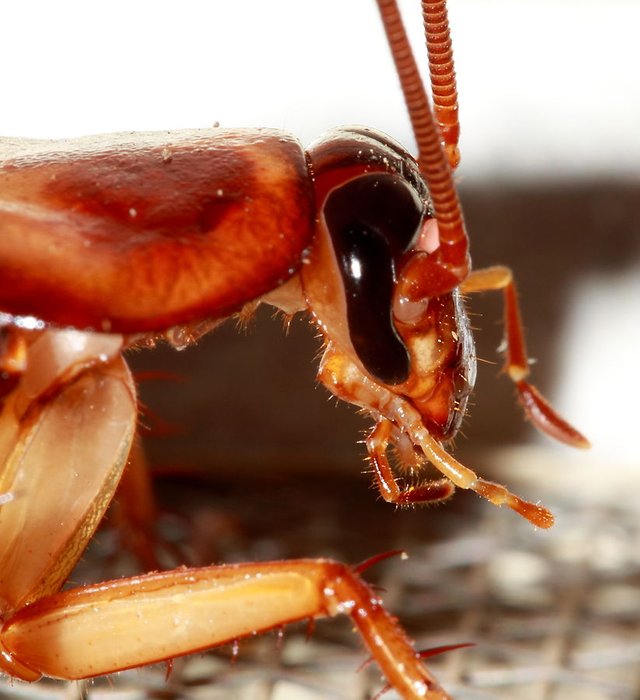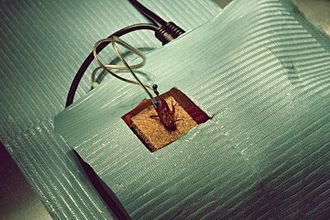The cockroaches are an ancient group, with ancestors originating during the Carboniferous period, some 300-350 million years ago. Those early ancestors, however, lacked the internal ovipositors of modern roaches. Cockroaches are somewhat generalized insects lacking special adaptations (such as the sucking mouthparts of aphids and other true bugs); they have chewing mouthparts and are likely among the most primitive of living Neopteran insects. They are common and hardy insects capable of tolerating a wide range of climates, from Arctic cold to tropical heat. Tropical cockroaches are often much larger than temperate species. Contrary to popular belief, extinct cockroach relatives (Blattoptera) and 'roachoids' such as the Carboniferous Archimylacris and the Permian Apthoroblattina were not as large as the biggest modern species.
Some species, such as the gregarious German cockroach, have an elaborate social structure involving common shelter, social dependence, information transfer and kin recognition. Cockroaches have appeared in human culture since classical antiquity. They are popularly depicted as dirty pests, although the majority of species are inoffensive and live in a wide range of habitats around the world.
.jpg)
Most species of cockroach are about the size of a thumbnail, but several species are larger. The world's heaviest cockroach is the Australian giant burrowing cockroach Macropanesthia rhinoceros, which can reach 8 centimetres (3 in) in length and weigh up to 35 grams (1.2 oz).[21] Comparable in size is the Central American giant cockroach Blaberus giganteus. The longest cockroach species is Megaloblatta longipennis, which can reach 97 mm (3+7⁄8 in) in length and 45 mm (1+3⁄4 in) across. A Central and South American species, Megaloblatta blaberoides, has the largest wingspan of up to 185 mm (7+1⁄4 in). At the other end of the size scale, Attaphila cockroaches that live with leaf-cutter ants include some of the world's smallest species, growing to about 3.5 mm in length.
Head of Periplaneta americana
Cockroaches are generalized insects with few special adaptations, and may be among the most primitive living Neopteran insects. They have a relatively small head and a broad, flattened body, and most species are reddish-brown to dark brown. They have large compound eyes, two ocelli, and long, flexible antennae. The mouthparts are on the underside of the head and include generalized chewing mandibles, salivary glands and various touch and taste receptors.
The body is divided into a thorax of three segments and a ten-segmented abdomen. The external surface has a tough exoskeleton which contains calcium carbonate; this protects the inner organs and provides attachment to muscles. This external exoskeleton is coated with wax to repel water. The wings are attached to the second and third thoracic segments. The tegmina, or first pair of wings, are tough and protective; these lay as a shield on top of the membranous hind wings, which are used in flight. All four wings have branching longitudinal veins, as well as multiple cross-veins.
The three pairs of legs are sturdy, with large coxae and five claws each. They are attached to each of the three thoracic segments. Of these, the front legs are the shortest and the hind legs the longest, providing the main propulsive power when the insect runs. The spines on the legs were earlier considered to be sensory, but observations of the insect's gait on sand and wire meshes have demonstrated that they help in locomotion on difficult terrain. The structures have been used as inspiration for robotic legs.
The abdomen has ten segments, each having a pair of spiracles for respiration. In addition to the spiracles, the final segment consists of a pair of cerci, a pair of anal styles, the anus and the external genitalia. Males have an aedeagus through which they secrete sperm during copulation, while females have spermatheca for storing sperm and an ovipositor through which the oothecae are laid.

Because of their ease of rearing and resilience, cockroaches have been used as insect models in the laboratory, particularly in the fields of neurobiology, reproductive physiology and social behavior. The cockroach is a convenient insect to study as it is large and simple to raise in a laboratory environment. This makes it suitable both for research and for school and undergraduate biology studies. It can be used in experiments on topics such as learning, sexual pheromones, spatial orientation, aggression, activity rhythms and the biological clock, and behavioral ecology.Research conducted in 2014 suggests that humans fear cockroaches the most, even more than mosquitoes, due to an evolutionary aversion.
